Malaria Diagnostics Market Size
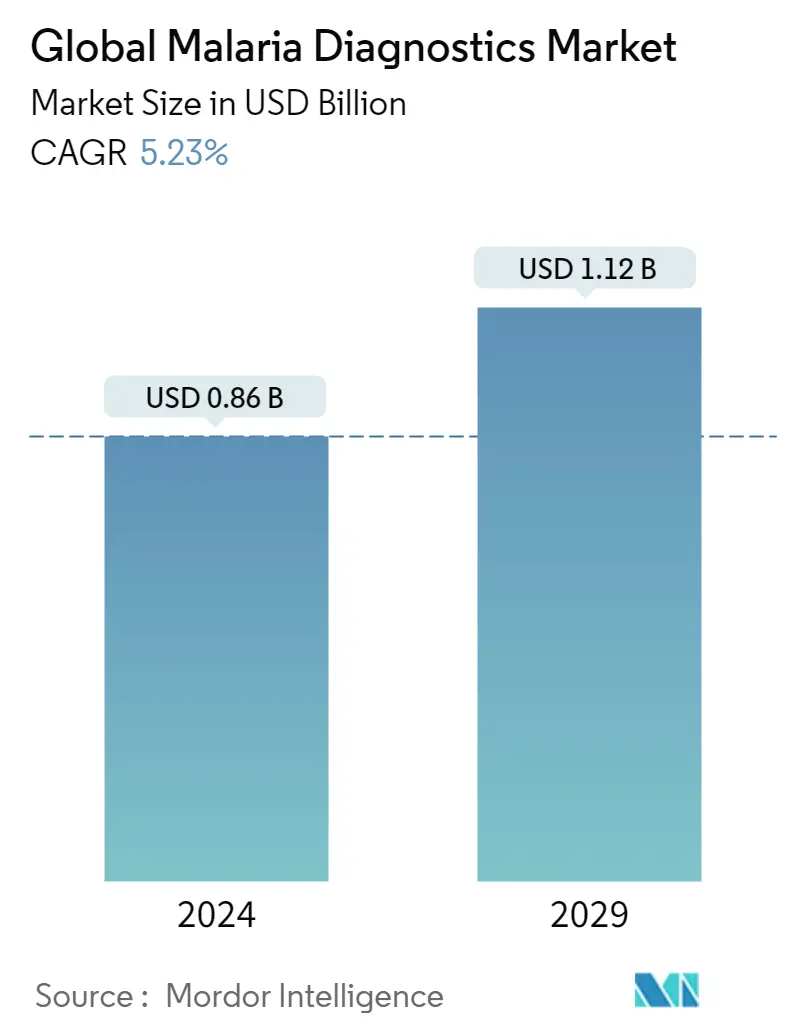
| Study Period | 2019 - 2029 |
| Market Size (2024) | USD 0.86 Billion |
| Market Size (2029) | USD 1.12 Billion |
| CAGR (2024 - 2029) | 5.23 % |
| Fastest Growing Market | Middle East and Africa |
| Largest Market | North America |
| Market Concentration | Low |
Major Players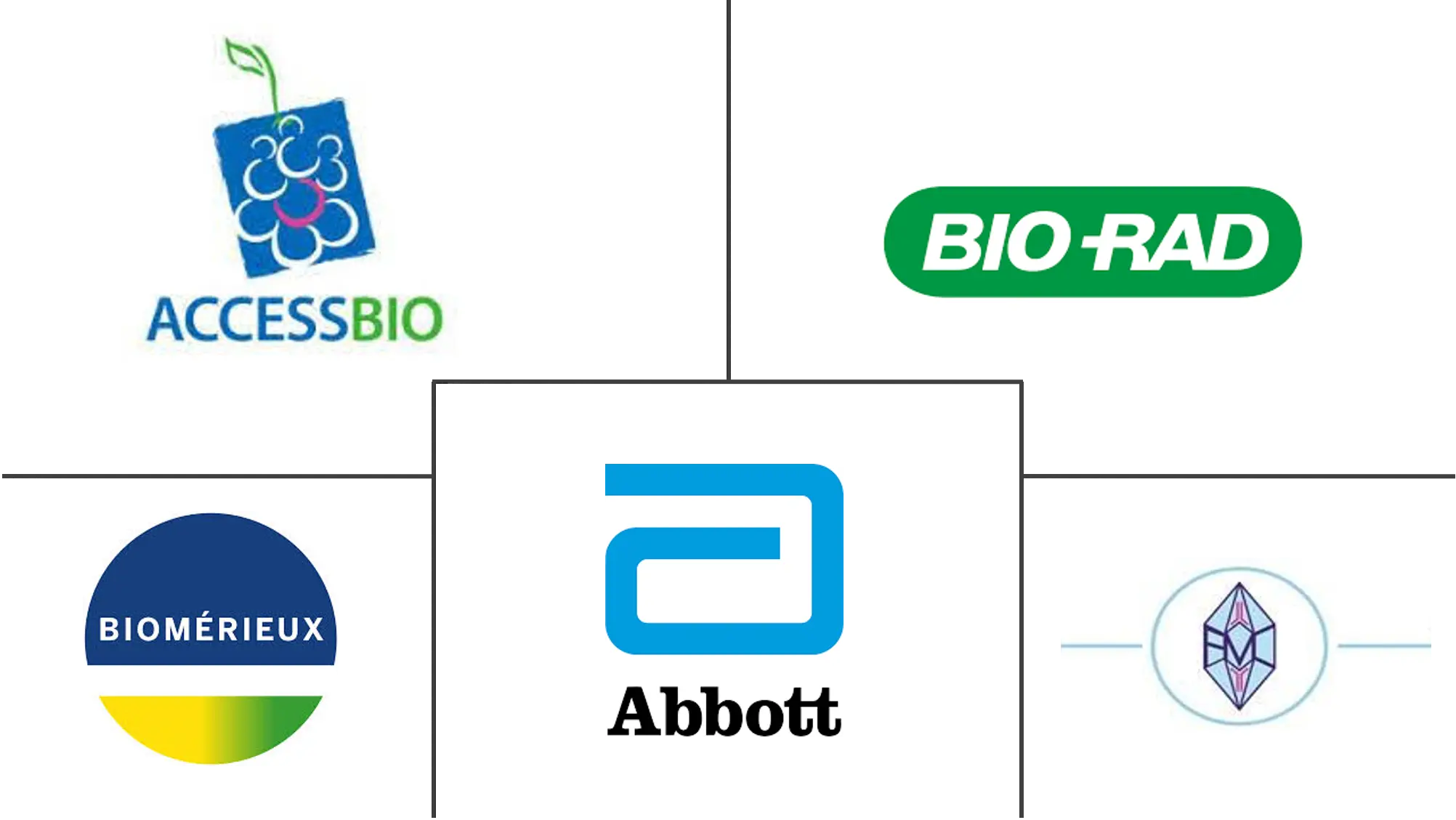
*Disclaimer: Major Players sorted in no particular order |
Malaria Diagnostics Market Analysis
The Global Malaria Diagnostics Market size is estimated at USD 0.86 billion in 2024, and is expected to reach USD 1.12 billion by 2029, growing at a CAGR of 5.23% during the forecast period (2024-2029).
The COVID-19 pandemic is expected to have a significant impact on the market. According to an article titled, 'Diagnosing malaria and other febrile illnesses during the COVID-19 pandemic' that appeared in The Lancet online magazine in April 2020, social distancing measures implemented to manage COVID-19 were making it difficult for personnel to access patients with fever, potentially compromising testing and diagnostics for the disease. Additionally, according to another article published in July 2020 titled, 'Identifying and combating the impacts of COVID-19 on malaria', children and pregnant women would bear a disproportionate burden of excess malaria mortality arising from COVID-19-related disruption of health systems and malaria control programs, particularly in sub-Saharan Africa. This is primarily because the current COVID-19 pandemic is disrupting malaria diagnosis as both these diseases share some symptoms. It is because of these factors that the malaria diagnostics market is expected to be affected during the COVID-19 pandemic.
The factors that are responsible for the growth of this market include the growing demand for diagnostic tools in malaria-endemic regions, the high incidence of malaria in some regions, increasing technological advancements and efficient diagnostics, the scale-up of rapid diagnostic tests, and universal access to diagnosis. The rising demand for diagnostic tools for malaria is one of the primary factors driving the market study. For instance, according to the July 2022 update of the World Health Organization (WHO), there were 241 million new cases of malaria registered in 2020 globally, an increase of 14 million cases from the previous year. Also, as per the same source, a disproportionately large amount of the worldwide malaria burden is found in the WHO African Region and 95% of malaria cases and 96% of malaria deaths occurred in the area in 2020. Hence, due to the high burden of malaria around the world, the demand for malaria diagnostics products is expected to increase which will drive growth in the malaria diagnostics market over the forecast period. In addition, awareness programs and other government initiatives are other factors in market growth. For instance, in July 2022, the Ministry of Health and Family Welfare of India launched Jan Abhiyaans with log bhaagidari (people's participation) to enthuse and engage citizens and communities to ensure that their homes, premises, and neighborhoods are free of mosquitoes. Thus, such initiatives are likely to increase awareness among people thereby providing growth opportunities for the market.
Furthermore, the technological advancement in the malaria diagnostics techniques and launch of new products in the market by the companies in the market along with other business expansion activities such as collaborations, mergers and acquisitions, and expansion are also expected to play a crucial role in the growth of the malaria diagnostics market over the forecast period. For instance, in July 2022, Mylab Discovery Solutions launched a combined RT-PCR test called PathoDetect Extended Monsoon Fever Panel, for monsoon diseases such as malaria, Chikungunya, dengue, Zika, Leptospirosis and Salmonellosis bacterial species, and Leishmaniasis parasites. Therefore, due to the above-mentioned factors, the malaria diagnostics market is expected to grow over the forecast period. However, the increasing number of malaria-free countries and rising demand for low-cost diagnostic tools are expected to hinder the growth of the malaria diagnostics market over the forecast period.
Malaria Diagnostics Market Trends
This section covers the major market trends shaping the Malaria Diagnostics Market according to our research experts:
Microscopic Diagnostics is Expected to Hold the Highest Market Share in the Technology Segment
Microscopy diagnosis of malaria is a relatively simple and established technique that is familiar to most laboratory personnel. Most laboratories that can perform a routine hematology test are equipped to perform a thin and thick malaria smear. This test is used extensively for the detection of malaria since it can provide valuable information within a few hours of collecting the blood. Initially, the test is used to determine whether malaria parasites are present in the patient's blood. Once the diagnosis is established by detecting parasites in the thick smear, the laboratorian can then examine the thin smear to determine the malaria species and the parasitemia, or the percentage of the patient's red blood cells that are infected with malaria parasites. Microscopy results are only as reliable as the laboratories performing the tests. In the United States, there are, on average, 2,000 cases of malaria diagnosed and reported each year. Similarly, research studies provide insight into the usage of microscopy for the diagnosis of malaria. For instance, in June 2021, a research study published titled "Diagnostic performance of the rapid diagnostic test, light microscopy and polymerase chain reaction during a mass survey conducted in low and high malaria-endemic areas from two North-Eastern states of India" stated that malaria diagnosis is routinely performed by microscopy and rapid diagnostic tests (RDTs) in the field settings; however, their performance may vary across regions, age and asymptomatic status. A total of 3,322 individuals were screened for malaria using RDT, microscopy, and PCR, and measures of diagnostic accuracy were estimated. The conventional diagnostic tools (RDT and microscopy) detected malaria in children with nearly twofold greater sensitivity than in adults. Thus, such studies provide insight into the advantages of using microscopy for malaria diagnosis. Hence, such studies are expected to increase the market growth. Expansion by key market players is another factor in market growth. For instance, in June 2021, Nikon Corporation expanded the Australian subsidiary, Nikon Australia, through the addition of the Healthcare Business Unit that will focus on the expansion and development of its microscopes across New Zealand, Australia, and the Pacific region. Hence, owing to the above-mentioned factors, the microscopy diagnosis segment is expected to have a significant market share over the forecast period.
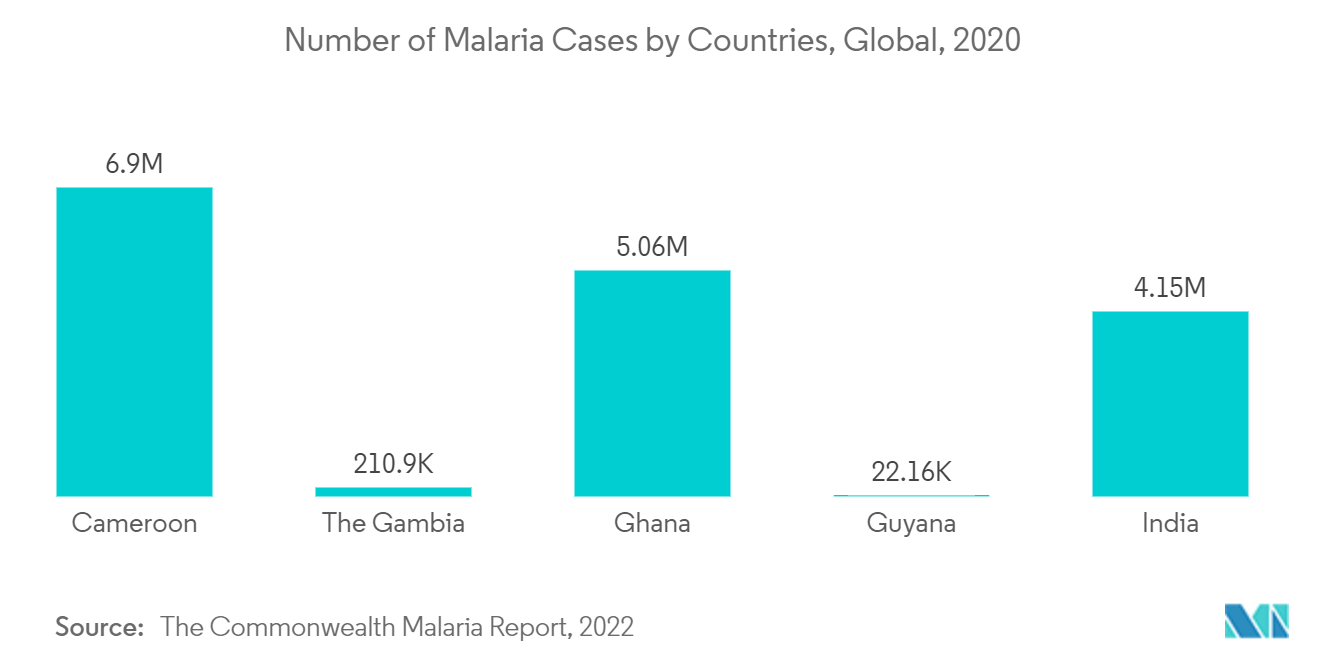
Asia-Pacific & Middle East Region is Expected to Hold a Significant Market Share in the Malaria Diagnostics Market Over Forecast Period
The Middle East and Africa region are expected to retain dominance in the market share over the forecast period, due to the rising investments by the developed countries, such as the United States and the United Kingdom, larger patient populations, coupled the rising focus of the World Health Organization (WHO) to reduce the mortality rate of malaria in the African countries. According to the July 2022 data published by the World Health Organization, Sub-Saharan Africa likely continues to endure the burden of malaria, accounting for approximately 95% of all cases and 96% of all deaths. Further, according to the data published by the World Health Organization, in 2021, the evidence of the occurrence of mutations linked to partial artemisinin, which is the first-line treatment for uncomplicated P. falciparum malaria, resistance found in Rwanda in Africa. P. falciparum is the most prevalent malarial parasite in the region, accounting for an estimated 99% of all cases in Africa.
According to the 2021 World Malaria Report by the World Health Organization, in 2020, about 228,000 new cases of malaria were recorded in the WHO Africa region and 5,700 new malaria cases in the Eastern Mediterranean region. Also, as per the same source, the case of malaria is increasing in this region over the years and thus, it is anticipated that the demand for malaria diagnostics products to be high in the region over the forecast period. In addition, the rising need for early detection and increased awareness regarding malaria diagnosis is expected to propel the demand for the malaria diagnostics market in this region. Therefore, owing to the above-mentioned factors, the Asia-Pacific & Middle East region is expected to occupy a significant share of the malaria diagnostics market over the forecast period.
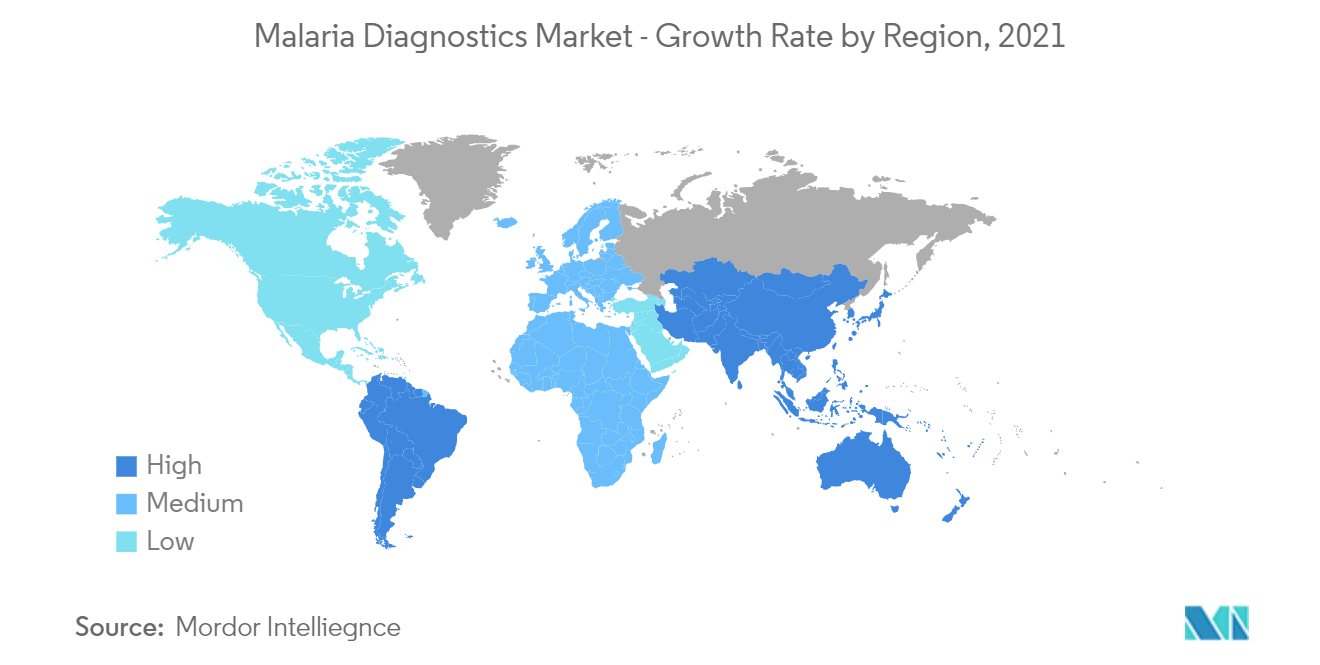
Malaria Diagnostics Industry Overview
The malaria diagnostics market is moderately competitive and consists of several major players. In terms of market share, a few of the major players currently dominate the market. With the rising prevalence of diseases, a few other smaller players are also expected to enter into the market and hold a substantial share. For instance, bioMérieux has a vast network of distributors in more than 150 countries through 42 subsidiaries providing diagnostic solutions. Some of the major players of the market are Alere Inc., Abbott Laboratories, bioMérieux SA, Bio-Rad Laboratories Inc., and Premier Medical Corporation Ltd, among others.
Malaria Diagnostics Market Leaders
-
Abbott Laboratories
-
Bio-Rad Laboratories Inc.
-
Access Bio Inc.
-
Premier Medical Corporation Ltd
-
BioMérieux SA
*Disclaimer: Major Players sorted in no particular order
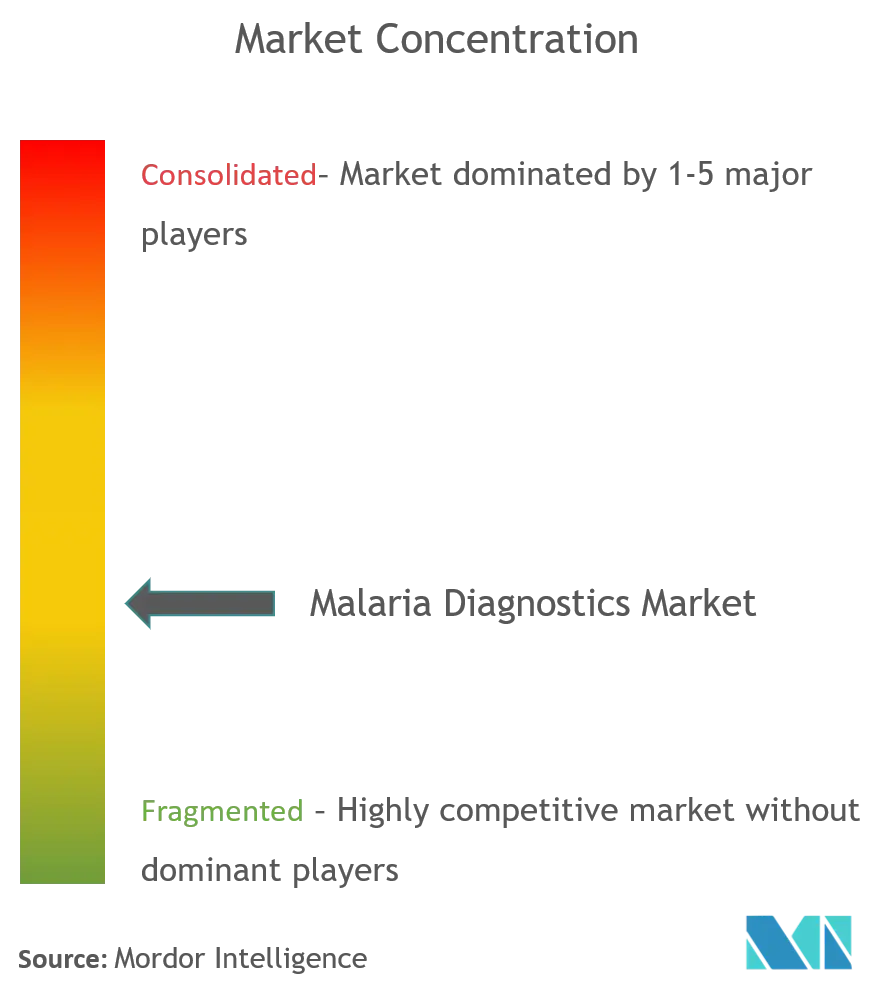
Malaria Diagnostics Market News
- In June 2022, SC Johnson and Global Fund partnered to eradicate malaria. The Global Fund provides 56% of all international financing for malaria programs (39% of total available resources) and invested more than USD 16 billion in malaria control programs to date.
- In February 2022, Kenya Medical Research Institute (KEMRI) launched Plasmochek diagnostic kit against malaria.
Malaria Diagnostics Market Report - Table of Contents
1. INTRODUCTION
1.1 Study Assumptions and Market Definition
1.2 Scope of the Study
2. RESEARCH METHODOLOGY
3. EXECUTIVE SUMMARY
4. MARKET DYNAMICS
4.1 Market Overview
4.2 Market Drivers
4.2.1 Growing Demand for Diagnostic Tools in Malaria-endemic Regions
4.2.2 Increasing Technological Advancements and Efficient Diagnostics
4.2.3 Scale-up of Rapid Diagnostic Tests and Universal Access to Diagnosis
4.3 Market Restraints
4.3.1 Increasing Number of Malaria-free Countries
4.3.2 Rising Demand for Low-cost Diagnostic Tools
4.4 Porter's Five Forces Analysis
4.4.1 Threat of New Entrants
4.4.2 Bargaining Power of Buyers/Consumers
4.4.3 Bargaining Power of Suppliers
4.4.4 Threat of Substitute Products
4.4.5 Intensity of Competitive Rivalry
5. MARKET SEGMENTATION (Market Size by Value - USD million)
5.1 By Technology
5.1.1 Clinical Diagnostics
5.1.2 Microscopic Diagnostics
5.1.3 Rapid Diagnostic Tests (RDTs)
5.1.4 Molecular Diagnostics
5.1.5 Other Technologies
5.2 Geography
5.2.1 Americas
5.2.1.1 Venezuela
5.2.1.2 Brazil
5.2.1.3 Colombia
5.2.1.4 Rest of the Americas
5.2.2 Europe
5.2.2.1 Germany
5.2.2.2 United Kingdom
5.2.2.3 France
5.2.2.4 Turkey
5.2.2.5 Spain
5.2.2.6 Rest of Europe
5.2.3 Asia-Pacific & Middle East
5.2.3.1 India
5.2.3.2 Myanmar
5.2.3.3 Indonesia
5.2.3.4 Pakistan
5.2.3.5 China
5.2.3.6 Papua New Guinea
5.2.3.7 Cambodia
5.2.3.8 Rest of Asia-Pacific & middle East
5.2.4 Africa
5.2.4.1 Democratic Republic of Congo
5.2.4.2 Nigeria
5.2.4.3 Uganda
5.2.4.4 Rest of Africa
6. COMPETITIVE LANDSCAPE
6.1 Company Profiles
6.1.1 Access Bio Inc.
6.1.2 Abbott Laboratories
6.1.3 BioMerieux SA
6.1.4 Ortho Clinical Diagnostics
6.1.5 Thermo Fisher Scientific
6.1.6 Premier Medical Corporation Pvt. Ltd
6.1.7 Siemens Healthineers
6.1.8 Bio-Rad Laboratories Inc.
6.1.9 Nikon Corporation
6.1.10 Advy Chemical Pvt Ltd
6.1.11 Zephyr Biomedicals
6.1.12 AdvaCare Pharma
- *List Not Exhaustive
7. MARKET OPPORTUNITIES AND FUTURE TRENDS
Malaria Diagnostics Industry Segmentation
As per the scope of the report, malaria is a serious life-threatening disease caused by a parasite, transmitted by the bite of infected anopheles mosquitoes. Infected mosquitoes transport the plasmodium parasite. The report studies the different types of methods used for the diagnosis of malaria. The malaria diagnostics market is segmented by technology (clinical diagnostics, microscopic diagnostics, rapid diagnostic tests, molecular diagnostics, and other technologies) and geography (Americas, Europe, Asia-Pacific & Middle East, and Africa). The report offers the value (in USD million) for the above segments.
| By Technology | |
| Clinical Diagnostics | |
| Microscopic Diagnostics | |
| Rapid Diagnostic Tests (RDTs) | |
| Molecular Diagnostics | |
| Other Technologies |
| Geography | ||||||||||
| ||||||||||
| ||||||||||
| ||||||||||
|
Malaria Diagnostics Market Research FAQs
How big is the Global Malaria Diagnostics Market?
The Global Malaria Diagnostics Market size is expected to reach USD 0.86 billion in 2024 and grow at a CAGR of 5.23% to reach USD 1.12 billion by 2029.
What is the current Global Malaria Diagnostics Market size?
In 2024, the Global Malaria Diagnostics Market size is expected to reach USD 0.86 billion.
Who are the key players in Global Malaria Diagnostics Market?
Abbott Laboratories, Bio-Rad Laboratories Inc., Access Bio Inc., Premier Medical Corporation Ltd and BioMérieux SA are the major companies operating in the Global Malaria Diagnostics Market.
Which is the fastest growing region in Global Malaria Diagnostics Market?
Middle East and Africa is estimated to grow at the highest CAGR over the forecast period (2024-2029).
Which region has the biggest share in Global Malaria Diagnostics Market?
In 2024, the North America accounts for the largest market share in Global Malaria Diagnostics Market.
What years does this Global Malaria Diagnostics Market cover, and what was the market size in 2023?
In 2023, the Global Malaria Diagnostics Market size was estimated at USD 0.82 billion. The report covers the Global Malaria Diagnostics Market historical market size for years: 2019, 2020, 2021, 2022 and 2023. The report also forecasts the Global Malaria Diagnostics Market size for years: 2024, 2025, 2026, 2027, 2028 and 2029.
Malaria Diagnostics Industry Report
Statistics for the 2024 Malaria Diagnostics market share, size and revenue growth rate, created by Mordor Intelligence™ Industry Reports. Malaria Diagnostics analysis includes a market forecast outlook to 2029 and historical overview. Get a sample of this industry analysis as a free report PDF download.



